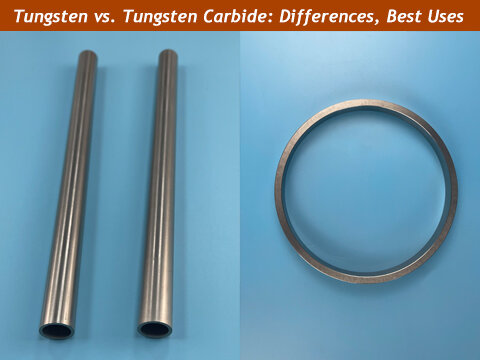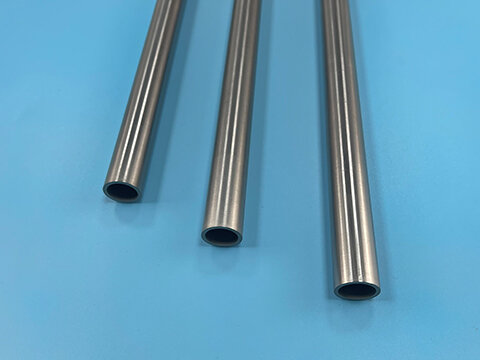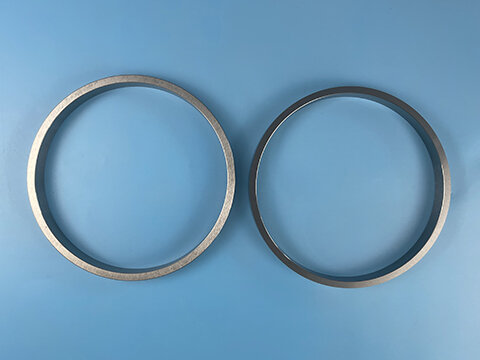Comparing Tungsten & Tungsten Carbide: Properties, Uses & Selection Tips
views, Updated: November 08, 2024 by aemmetal

What's So Special About Tungsten and Tungsten Carbide?
Tungsten and tungsten carbide—two heavyweight materials (literally and figuratively!) that pack a serious punch in the industrial world. Whether you're working in aerospace, manufacturing, mining, or just curious about these metals, understanding their unique properties can help you pick the right one for your needs. Let's dive in!
Tungsten: The Super-Metal with Extreme Heat Resistance

So, What is Tungsten?
Tungsten, sometimes called "wolfram," is a metal like no other. With the chemical symbol W and an atomic number of 74, it's famous for being super tough and incredibly heat-resistant. Here's why it's so unique:
Key Properties of Tungsten
-
Sky-High Melting Point
Tungsten has the highest melting point of any metal, a jaw-dropping 3,422°C (6,192°F). Just imagine how hot that is! This makes tungsten perfect for industries where materials have to survive extreme temperatures—think rocket engines and furnaces.
-
Incredible Density
Tungsten is heavy. Really heavy. With a density of 19.3 grams per cubic centimeter, it's one of the densest materials around. This high density is useful when you need a lot of weight packed into a small space, like in counterweights or ballast keels for ships.
-
Toughness and Hardness
On the Mohs scale (which measures hardness), tungsten scores about 7.5. That means it's pretty scratch-resistant, making it a go-to choice for cutting tools and industrial equipment that take a beating day in and day out.
-
Strength That Holds Up
Tungsten's tensile strength is impressive, meaning it can handle a ton of stress without breaking. If you need a material that's not going to buckle under pressure, tungsten is a top contender.
-
Efficient Heat Conductor
Tungsten doesn't just resist heat; it's also great at conducting it. This property makes it valuable in electronics, where managing heat is crucial. You'll find tungsten in everything from light bulb filaments to X-ray tubes.
Where Will You Find Tungsten in Action?
Tungsten isn't just hanging out in labs; it's out there in the real world doing some serious heavy lifting.
-
Aerospace & Defense: From missile components to rocket nozzles, tungsten's heat resistance and density make it essential for high-stress, high-heat applications.
-
Electronics: Tungsten's conductivity shines in electronic devices, especially in filaments for light bulbs and as contacts in various gadgets.
-
Industrial Gear: Cutting tools, mining equipment, you name it—if it's getting pounded by hard work, tungsten's in the mix, helping it last longer and perform better.
-
Medical Uses: Tungsten's density helps it block radiation, making it perfect for shielding in medical imaging and certain medical instruments.
Tungsten Carbide: The Ultra-Hard Compound for High-Wear Applications
What Exactly is Tungsten Carbide?

Tungsten carbide isn't pure tungsten; it's a compound made by combining tungsten and carbon atoms. The result? A material that's nearly as hard as diamond, highly resistant to wear, and perfect for industrial use. Here's what makes tungsten carbide a superstar in its own right:
Key Properties of Tungsten Carbide
-
Rock-Solid Hardness
Tungsten carbide scores about 9 on the Mohs scale, just shy of diamond. This hardness makes it almost impervious to scratching, ideal for tools that need to stay sharp and intact over time.
-
Wear-Resistant Powerhouse
Because of its hardness, tungsten carbide can withstand high levels of abrasion. That's why you see it in mining and drilling equipment, where materials are constantly grinding and scraping against rough surfaces.
-
Serious Strength
Like pure tungsten, tungsten carbide is incredibly strong and can handle a lot of stress without deforming, which is essential for heavy-duty applications.
-
Still Pretty Dense
With a density of around 15.6 grams per cubic centimeter, tungsten carbide is slightly less dense than pure tungsten but still packs a good heft, making it durable and robust.
-
Corrosion-Resistant
Unlike some metals, tungsten carbide doesn't corrode easily, so it stays solid even when exposed to harsh conditions—perfect for industrial environments.
-
High Melting Point
Tungsten carbide can handle heat up to 2,870°C (5,198°F), so you don't have to worry about it losing its shape under high temperatures.
Where Does Tungsten Carbide Shine?
Tungsten carbide's toughness isn't just for show—it's out there in the field making a difference.
-
Cutting Tools & Abrasives: Known for its hardness, tungsten carbide is a favorite for cutting tools used in metalworking, woodworking, and construction.
-
Mining & Drilling Gear: Tungsten carbide drill bits can cut through some seriously tough rock without breaking down. Perfect for the rough conditions in mining.
-
Industrial Machinery: Bearings, seals, nozzles—parts that need to endure wear and tear benefit from tungsten carbide's durability.
-
Aerospace: In aerospace engines, tungsten carbide parts stand up to high-speed wear, helping them last longer and perform better.
-
Jewelry: Yes, tungsten carbide is even used for jewelry like rings because it's scratch-resistant and stays shiny over time!
Comparing Tungsten vs. Tungsten Carbide: What's the Difference?
If you're trying to decide between these two, here's a quick breakdown to help you understand their strengths and differences.
1. Composition
-
Tungsten: Pure metal with a body-centered cubic crystal structure.
-
Tungsten Carbide: A compound made of tungsten and carbon, creating a dense, super-hard material.
2. Melting Point
-
Tungsten: Higher melting point at 3,422°C (6,192°F).
-
Tungsten Carbide: Lower but still high at 2,870°C (5,198°F).
3. Density
-
Tungsten: Denser at 19.3 grams per cubic centimeter.
-
Tungsten Carbide: Slightly less dense at around 15.6 grams per cubic centimeter.
4. Hardness
-
Tungsten: Tough, scoring about 7.5 on the Mohs scale.
-
Tungsten Carbide: Extremely hard, scoring around 9—almost diamond-level hardness.
Choosing the Right Material for Your Project
Picking between tungsten and tungsten carbide depends on what your project needs. Here are some things to consider:
-
Heat Tolerance: For applications exposed to extreme heat, tungsten's higher melting point might be more suitable.
-
Wear Resistance: If you need something that can handle serious abrasion, tungsten carbide's hardness is unbeatable.
-
Budget: Tungsten carbide is usually more expensive, but its long life could save you money in the long run if you're replacing parts less frequently.
-
Customization: Both materials can be customized, but it's essential to work with a supplier who knows their stuff.
Final Thoughts
Whether you go with tungsten for its heat resistance or tungsten carbide for its unparalleled hardness, each material has unique advantages.
At AEM METAL, we pride ourselves on being a trusted tungsten manufacturer. We offer high-quality tungsten products and have the expertise to guide you in making the best choice for your specific application.
Ready to make a choice that boosts performance and durability? Let’s talk about what tungsten or tungsten carbide can do for you.













